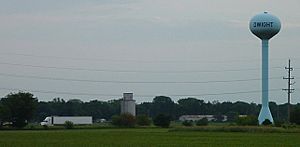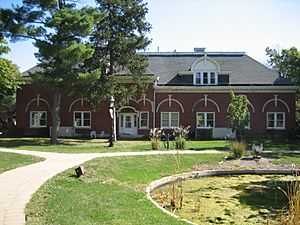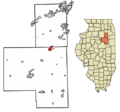Dwight, Illinois facts for kids
Quick facts for kids
Dwight, Illinois
|
|
|---|---|
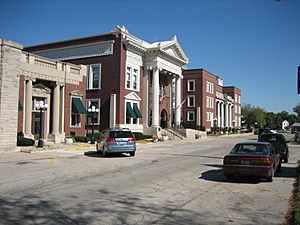
Buildings in downtown Dwight
|
|
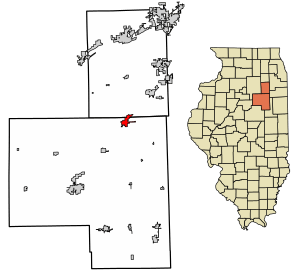
Location in Livingston and Grundy counties, Illinois
|
|
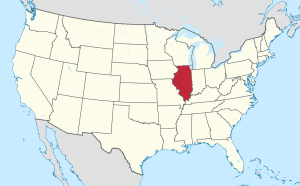
Location of Illinois in the United States
|
|
| Country | United States |
| State | Illinois |
| Counties | Livingston, Grundy |
| Townships | Dwight, Goodfarm |
| Area | |
| • Total | 3.31 sq mi (8.56 km2) |
| • Land | 3.30 sq mi (8.54 km2) |
| • Water | 0.01 sq mi (0.02 km2) |
| Elevation | 633 ft (193 m) |
| Population
(2020)
|
|
| • Total | 4,032 |
| • Density | 1,222.93/sq mi (472.17/km2) |
| Time zone | UTC−6 (CST) |
| • Summer (DST) | UTC−5 (CDT) |
| ZIP code |
60420
|
| Area code(s) | 815 |
| FIPS code | 17-21358 |
| GNIS ID | 2398764 |
| Wikimedia Commons | Dwight, Illinois |
Dwight is a small village in Illinois, USA. It is mostly in Livingston County, Illinois, with a small part in Grundy County. In 2020, about 4,032 people lived there. Dwight is famous for having an original part of U.S. Route 66. It also had a railroad station designed by Henry Ives Cobb that was used for a very long time, from 1892 until 2016. A major highway, Interstate 55, goes around the village.
Contents
Where is Dwight, Illinois?
Dwight is located in the northeastern part of Livingston County. It stretches north into Grundy County, where you can find some shops near the Interstate 55 exit. Interstate 55 connects Dwight to Chicago, which is about 77 miles northeast. It also leads southwest to Bloomington, about 58 miles away.
Roads and Highways
Several important roads pass through or near Dwight:
- Illinois Route 17 goes through the center of Dwight. It's called Mazon Avenue. This route goes east about 30 miles to Kankakee and west about 34 miles to Wenona.
- Illinois Route 47 (Union Street) is on the east side of Dwight. It goes north about 18 miles to Morris and south about 44 miles to Gibson City.
Land and Water
Dwight covers a total area of about 3.23 square miles (8.37 square kilometers). Most of this area, about 3.22 square miles (8.34 square kilometers), is land. Only a tiny part, about 0.01 square miles (0.03 square kilometers), is water.
A Look at Dwight's History
How Dwight Started
Dwight was planned on January 30, 1854. Three engineers from the Chicago and Mississippi Railroad – Richard Price Morgan Jr., James C. Spencer, and John Lathrop – each bought a quarter of the land. The last quarter was owned by two brothers from Bloomington, Jesse W. Fell and Kersey H. Fell. All five men were connected to the railroad, which was set to open in 1854.
The founders planned to buy land along the railroad route and divide it. Morgan was in charge of planning the new town, selling the lots, and sharing the money. The train station was placed where the four land sections met. The town was named after Henry Dwight, who helped pay for building this part of the railroad. The Chicago and Mississippi Railroad later became the Chicago and Alton Railroad.
Early Days in Dwight
When the railroad surveyors arrived in 1853, they found the tracks would go slightly east of the planned center. This meant Morgan's land would be more valuable. So, they changed the plan: everyone gave their land to Morgan, who would sell it all and split the profits.
To let people know a town was coming, a tin pan was put on a telegraph pole. Railroad workers came to the town site. The first building in Dwight was a boarding house built by John Campbell. The first house was built by Augustus West in June 1854. The first passenger train arrived in Dwight on July 4, 1854. Regular train service started in August that year.
The first store opened in 1855. It was a two-story white building owned by David McWilliams. In 1857, John Spencer started buying grain and built a warehouse. A grain elevator and a large stone mill followed soon after.
Dwight's Original Design
Like many new towns in Illinois in the 1850s, Dwight was designed around a "depot ground" instead of a town square. This was a wide area of railroad property, about 1000 feet long and 200 feet wide, where the tracks went through town.
The early train station was on the northwest side of the tracks. Dwight's first town plan was quite large, with 24 blocks, each having 28 lots.
A Royal Visit!
In 1860, Prince Albert, who would later become King Edward VII of England, visited Dwight. He was the son of Queen Victoria. The prince stayed for several days at the farm of James C. Spencer, one of Dwight's founders. The visit was so important that people remembered the exact time he arrived: 6:27 PM on Saturday, September 22, 1860.
The prince and his group went hunting and caught over 200 prairie chickens and quail. Prince Albert also went to Sunday services at the local Presbyterian church. On September 26, he left, but not before planting an elm tree on Spencer's farm. Today, the land where the prince stayed is a park called Renfrew Park.
How Dwight Grew
In 1869, Dwight's future looked even brighter when a second railroad line was built. This new line connected Dwight to Streator. In the same year, the Chicago and Alton Railroad added a second track from Odell to Gardner.
The first brick house in Dwight was built in 1872. A well-known medical institute, the Keeley Institute, opened in Dwight. Its success helped pay for the John R. Oughton House, built in 1891. This house is now on the National Register of Historic Places.
In 1881, another railroad, the Illinois, Indiana and Iowa Railroad, was built through Dwight. This gave the town a second train station. This line later became part of the New York Central Railroad.
By 1891, Dwight needed a new main train station. The C&A Railroad hired Henry Ives Cobb to design it. The result was a beautiful building called the Dwight Railroad Station, which is now on the National Register of Historic Places. Another famous building downtown is the Frank L. Smith Bank, designed by the famous architect Frank Lloyd Wright, which opened in 1906.
In 1906, an electric railway opened, connecting Dwight to Pontiac. This was meant to be part of a fast electric train service from Chicago to St. Louis, but it was never fully built.
In 1921, the road from Chicago to Springfield was paved. In 1926, this road became famous as Route 66. The new road made the electric railway less popular, and it closed in 1925. In 1964, the first part of Interstate 55 was finished, making Dwight more focused on highway travel.
In 1930, the state of Illinois opened the Oakdale Reformatory for Women west of the village. This later became the Dwight Correctional Center.
June 2010 Tornado
On June 5, 2010, a strong tornado, called an EF-3 tornado, passed through nearby Streator and then Dwight. While it caused damage, many people in Dwight were thankful that their town was mostly spared the worst of the storm.
Famous Buildings and Places
Dwight is home to some very special buildings:
- The First National Bank of Dwight is one of only three banks ever designed by the famous architect Frank Lloyd Wright.
- A historic U.S. Route 66 Texaco gas station, called Ambler's Texaco Gas Station, is also listed on the National Register of Historic Places.
- The 1891 railway station is also on the National Register of Historic Places.
- The 1857 Dwight Pioneer Gothic Church is a rare example of a wooden church built in the Carpenter Gothic style.
- The John R. Oughton House is another historic building in Dwight.
People of Dwight
In 2020, Dwight had 4,032 residents. There were 1,544 households, and 1,017 families living in the village. About 91% of the people were White.
The average age of people in Dwight was 40.7 years old. About 22.2% of the population was under 18 years old.
Notable People from Dwight
Many interesting people have connections to Dwight:
- Hannah Tracy Cutler: An important person who worked to end slavery.
- Tim Lee Hall: A congressman from Illinois who taught in Dwight.
- Clay Harbor: A player in the National Football League and a Reality TV star who grew up in Dwight.
- Art Mathisen: A college basketball star at the University of Illinois who was born in Dwight.
- Diana Oughton: A student activist who was born in Dwight.
- Frank L. Smith: A congressman from Illinois.
- James G. Strong: A congressman from Kansas who was born in Dwight.
- Mabel Trunnelle: An early film actress who was born in Dwight.
- Jerry Weller: A congressman from Illinois.
Images for kids
See also
 In Spanish: Dwight (Illinois) para niños
In Spanish: Dwight (Illinois) para niños


